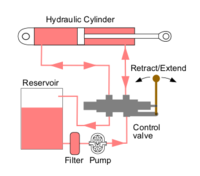
Photo from wikipedia
Nowadays, press-fitting is widely used in the manufacturing industry because it allows easy and fast installation and is repetitive, strong, and inherently reliable. The quality of a press-fitting assembly can… Click to show full abstract
Nowadays, press-fitting is widely used in the manufacturing industry because it allows easy and fast installation and is repetitive, strong, and inherently reliable. The quality of a press-fitting assembly can be verified from the press-fitting curves and forced monitoring. This study aims to investigate the characteristics of the press-fitting curve with various interference railway wheelset models and determine the interference limit that axles can withstand at the maximum holding torque without slipping and without plastic deformation. A three-dimensional finite element analysis examined the maximum press-fitting force and stress distributions using Abaqus FEA software. The press-fitting curves of the railway wheel and axle assembly obtained from finite element simulation were classified following European Standard EN 13260. The press-fitting curves showed whether they fell within the boundary limits in the EN standard to allow their practical application. This study also showed when plastic deformation would occur, within the recommended interferences in the EN standard. Moreover, the effect of interference was numerically simulated for the maximum holding torque capacity within the EN standard interference range. Numeric simulation was compared with the theory: the deviation was 15–6%.
Journal Title: Applied Sciences
Year Published: 2021
Link to full text (if available)
Share on Social Media: Sign Up to like & get
recommendations!